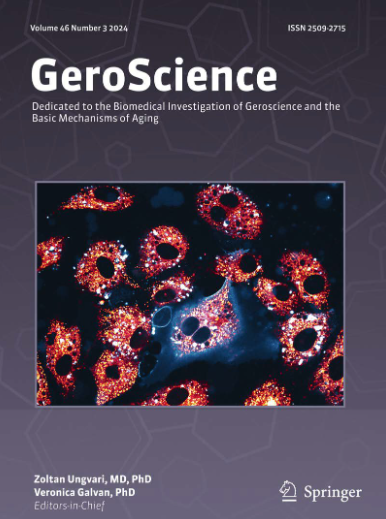CAIDE痴呆风险评分显示成年后期认知风险升高:一项结构和功能神经影像学研究。
IF 5.4
2区 医学
Q1 GERIATRICS & GERONTOLOGY
引用次数: 0
摘要
虽然CAIDE评分是一种已建立的用于痴呆纵向预测的中年风险评估工具,但其作为成年后期认知风险升高的测量方法的应用尚不清楚。使用详细的神经心理学评估以及结构和功能MRI对101名健康个体(年龄在50 - 55岁之间)进行了测试。参与者被分为低风险组(CAIDE 6)。高风险参与者在试验结果中的认知表现明显较差(TMT-B: t = -4.03, p = 0.0001),整体脑容量(如脑分割体积:t = 2.898, p = 0.0485)和区域脑容量(如伏隔体积:tleft = 3.928, p = 0.036, Cohen’s d = 0.828;right = 3.151, p= 0.0485, Cohen’s d = 0.656)。高风险参与者在默认模式、显著性和中央注意网络中也显示出功能连接减少的趋势。总的来说,CAIDE评分可能有助于识别成年后期人群中的认知高风险个体。本文章由计算机程序翻译,如有差异,请以英文原文为准。
The CAIDE dementia risk score indicates elevated cognitive risk in late adulthood: a structural and functional neuroimaging study.
While the CAIDE score is an established mid-life risk assessment tool for the longitudinal prediction of dementia, its application as a measure of elevated cognitive risk in late adulthood is unclear. One hundred one healthy individuals (aged > 55) were tested using detailed neuropsychological assessments, as well as structural and functional MRI. Participants were divided into a low-risk group (CAIDE < 7) and a high-risk group (CAIDE > 6). High-risk participants had significantly worse cognitive performance in the Trail-Making Test results (TMT-B: t = -4.03, p = 0.0001), and significantly smaller global brain volumes (e.g., brain segmentation volume: t = 2.898, p = 0.0485) and regional volumes (e.g., accumbens volumes: tleft = 3.928, p = 0.036, Cohen's d = 0.828; tright = 3.151, p= 0.0485, Cohen's d = 0.656). High-risk participants also showed a trend for reduced functional connectivity in the default mode, salience, and central attention networks. Overall, the CAIDE score might help identify cognitively high-risk individuals in a late adulthood population.
求助全文
通过发布文献求助,成功后即可免费获取论文全文。
去求助
来源期刊

GeroScience
Medicine-Complementary and Alternative Medicine
CiteScore
10.50
自引率
5.40%
发文量
182
期刊介绍:
GeroScience is a bi-monthly, international, peer-reviewed journal that publishes articles related to research in the biology of aging and research on biomedical applications that impact aging. The scope of articles to be considered include evolutionary biology, biophysics, genetics, genomics, proteomics, molecular biology, cell biology, biochemistry, endocrinology, immunology, physiology, pharmacology, neuroscience, and psychology.
 求助内容:
求助内容: 应助结果提醒方式:
应助结果提醒方式:


